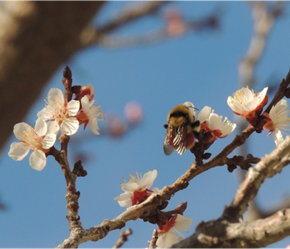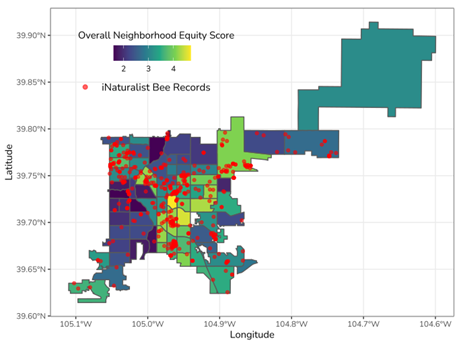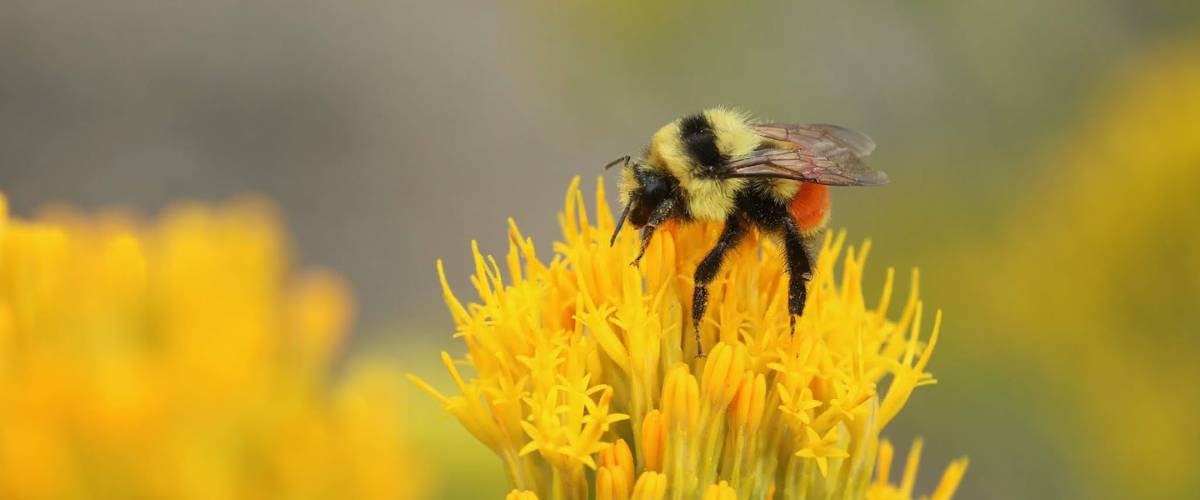Spring is here and everyday I am more excited for the arrival of my favorite things. No, not brewery patio beers. No, not gloves-free bicycle rides. Instead, my excitement is for the emergence of fluffy moths, the drunken meanderings of butterflies, and the dramatic antics of bees frantically gathering food for their offspring.
Perhaps when I talk about these insects, or when one thinks about nature and wildlife in general, we imagine day trips up to Rocky Mountain National Park or to some faraway “nature”. But nature is not some faraway thing – it’s right here in our neighborhoods. Our gardens, parks, roadside ditches or in the canopies of street trees. One of the most striking examples of this nature at home can be found in learning about the lives of bees, butterflies, and other pollinating insects. These pollinators can be your “Gateway Bugs”, helping you see the fascinating drama of the life of insects unfolding right in your city.
Some Basics About Pollinators

Around the world there are over 20,000 species of bee and over 180,000 species of Lepidoptera (Butterflies and Moths). Not to mention tens of thousands of other pollinating flies, wasps, beetles, birds, and more. The question “What is a pollinator?” is one of those simple questions with a surprisingly complex answer – so for now, let’s leave it at animals, primarily insects, that feed upon flowers. And most important among them are the bees, for they are the only ones that feed their offspring from pollen as their primary source of protein.
For many people, the honey bee might be a familiar sign of spring and the first bee we might think of when thinking of “the bees”. But these creatures represent only a tiny sliver of bee diversity. The European Honeybee (Apis mellifera) can be commonly found throughout the Front Range, but the species is not native to North America. It was brought here with the first European settlers (and in fact can often be a source of disease or competition for native species). Instead, along the Front Range you’ll want to keep your eyes and ears open to find bumble bees, mason bees, leaf cutter bees, and in total over 80 or so species of native bee living in our cities and towns. Check out this CSU Extension project on native bees for some more information on how to find or identify these species.
Why Care About this Diversity
Pollinator diversity, and their persistence in our cities, is important not only for the joy they can bring us in the springtime. An estimated nearly 90% of plants worldwide depend on pollination by animals. Additionally, for our agricultural industry, the pollination of crops amounts to an estimated over $200B every year. These important pollination services cannot be relied upon from just a single species, either. Global synthesis studies show that in all crop systems that rely on bee pollination, the addition of native, wild bee species always increased yields and/or crop quality beyond that of honeybees alone. Within urban environments, these bees are important to the pollination of crops in urban farms or gardens. On the western slope, pollinators contribute to the economically important orchard crops.
Concerns About Pollinator Declines
Despite a growing recognition of the importance of pollinators to our daily lives, there is a simultaneous and troubling body of research documenting regional and global declines of their populations. The presence of pollinators in our cities should not be taken for granted, it may not always be this way if we’re not careful. Factors like pesticide exposure, loss of flowering plants, and the impacts of heat and drought can make life tough for pollinators in the city. But we are not unaware of these stressors – we can make decisions about how to conserve or manage our natural resources.
In fact, there are several reasons to be hopeful about the fate of insects within urban environments. The presence of high densities of flowering plants due to gardens, parks, and street trees may help to offset the loss of wild flowering plants in areas that have been overgrazed or otherwise lost historic plant composition. Additionally, because gardeners often like to have something blooming for much of the growing season, sometimes these areas can provide a continuous source of floral resources rather than the “bloom and bust” cycles associated with agriculture or otherwise degraded lands. However, much remains to be learned about how we can best support pollinators in urban environments and ensure these species can be enjoyed and learned from for generations to come.
Conservation Action
But there is hope – there is a growing recognition of the value of green spaces not only for people, but also for pollinators. And there are substantial opportunities for win-win scenarios where we can increase the aesthetic value, value to pollinators, and climate resilience of our parks all in one.
My lab group at Colorado State University is working on a new project Denver Parks and Recreation and the Salazar Center for North American Conservation that will help provide guidance on conserving pollinator populations within Front Range communities (and hopefully beyond). This summer we’ll be conducting surveys of park goers and Denver residents to understand aesthetic and cultural preferences towards pollinator plantings. That should help us find win-win scenarios in conserving pollinators and building beautiful spaces. Additionally, we’ve been assembling a trait database on “pollinator friendly” plants to help build a plant selection tool for the city. Our philosophy is that there is no one “best plant” or mix of plants to support pollinators – instead, we need to be aware of the context of various goals and objectives in our efforts. If you’d like to read more about these projects, check out this CSU story.
How Can I Help?
That may be well and good that my lab is working on some plans with Denver Parks – but what can someone who is concerned about pollinator declines do to support populations in their city or backyard? The first thing – do NOT keep honeybees. Honeybees are important for agriculture, but they are domesticated species, not wild native pollinators. We like to say that keeping honey bees to “save the bees” would be like keeping chickens to “save the birds”. It can be a fun hobby for sure, but it is not a conservation action.
If you have space available, planting pollinator-friendly plants is an excellent way to provide food resources to pollinators and begin to learn about the insects that inhabit your space. We’re working on better guidance for municipalities, but for residents, CSU Extension already has some great guidance for home gardeners.
Perhaps my favorite way for folks to get involved though, is to contribute to research by documenting the bees and other pollinators you see on websites like iNaturalist.org or Bumble Bee Watch. This data, along with the associations with plants, has become a huge source of information for modeling population trends, learning about plant-pollinator associations, or documenting changes in species ranges. Contributing data to these sites is an excellent way to learn about pollinators while making an impact well beyond your home garden or neighborhood.

As the weather warms up, and the bees begin to emerge, I encourage you to look around and see if you can find nature close by. Soon, up above, you can find huge bumble bee queens beginning their seasons diligently collecting pollen and nectar from early-blooming trees like cherry, maple, and willows. Ground nesting bees jostle for territory in dirt patches at the edge of flower beds. Aggregations of males of solitary bee species form small frenetic clouds as they search for mates.
Perhaps by finding these creatures you can learn more about them and feel a greater connection to the world around us.

